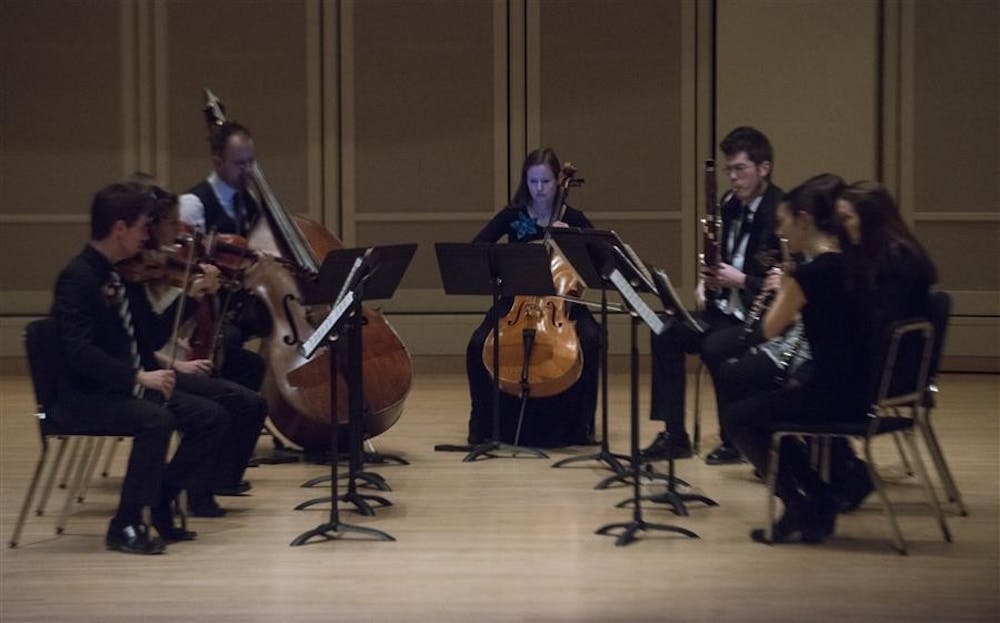Two hundred years of traditional classical music combined with the latest in cutting-edge artistic technology Saturday night, during a performance by Fifth House Ensemble at Jacobs School of Music’s Auer Hall.
The critically acclaimed chamber music ensemble from Chicago performed its piece “Black Violet: The Leagues of Despair.”
The performance, which used a projector and various images, was a joint effort between the ensemble and graphic novelist Ezra Claytan Daniels.
“We worked with the artist one-on-one to develop the music really to go with the story,” said Meredith Hite, Fifth House Ensemble’s oboist. “It really was a collaboration.”
Daniels, the graphic novelist of the “Black Violet” drama, has been praised for pioneering the live art spectacle and for developing new ways to combine artistic genres.
“There are all these beautiful characters in ‘Black Violet,’” Hite said. “Ezra is absolutely an amazing artist.”
“Black Violet” was set during the last resurgence of the Great Plague in 17th century London. It chronicles the story of Violet, a black house cat who is ostracized by her community for being a suspected carrier of the plague.
She wanders through the streets of London in search of her mistress. Daniels’ visual graphics are sketched in monochrome with characters bearing physically awkward joints and expressions.
“The story is really dark,” Hite said.
The ensemble employed pieces by five different artists, several of them contemporary, 20th and 21st century composers. In addition to the varied styles, the composers also come from a wide range of places like America, Germany and Brazil. Fifth House Ensemble celebrates these differences, but regards the music on its own standards, Hite said.
“We judge by what music is good,” she said. “It doesn’t have to be old. It doesn’t have to be new. It has to be good.”
The audience of more than 100 gave the performance two ovations.
Chamber music ensembles traditionally do not collaborate or use visuals to narrate music.
The genre dates back to the 17th-century Baroque period of music history and includes duets, string quartets, ensembles and small orchestras, which were played in small, single-room settings.
Despite using a screen projector, Hite said she believes Fifth House Ensemble is a part of the same tradition.
“The spirit of chamber music and how it began with a group of friends providing a small, intimate concert for themselves — we still try to bring that spirit to the community,” Hite said.
Community involvement and interaction with others is part of Fifth House Ensemble’s mission to make its music immediately personal for audiences. In “Luna de Cuernos,” another collaboration in its 2013-14 season, Fifth House Ensemble set a Puerto Rican creation myth to music, and presented it to a Puerto Rican community in Chicago to engage the audience with its own cultural history.
“What I love about Fifth House Ensemble is that we’re taking ourselves out of the equation,” Hite said. “We’re re-examining how the act appeals to the audience.”
The musicians are not the only ones who notice the new direction in which their ensemble is taking music. Director of Marketing and Publicity for the School of Music
Alain Barber was instrumental in bringing the ensemble to Auer Hall.
“They have a completely different set of ideals,” Barker said at the performance. “They maintain their sense of quality and craft in what they do.”
Other chamber music groups are also experimenting with the genre.
“It’s really a trend across the United States,” said Barker. “Multiculturalism has become a future of where art is going.”
Multiculturalism and the blending of artistic forms is also a musical tradition dating back to the 19th century.
In 1830, the French composer Hector Berlioz premiered his Symphonie Fantastique, a piece of program music, or music that narrates a specific story, widely considered to be the first of its kind. Hite, however, said he views the music of “Black Violet” to be more interpretative.
“I don’t ever want to assume that I think that the ‘Walter Piston Divertimento’ is a piece of program music,” she said, referring to one of the performance pieces. “We’re using it in a way to collaborate with narrative without disregarding the nature of what the composer intended.”
Constance Glen, an audience member as well as a senior lecturer at the music school, noted the cutting-edge use of visuals in the performance.
“They’re setting standards we want our students to know about,” Glen said. “They’re a very interesting group of musicians.”
“Black Violet: The Leagues of Despair,” the first act in a three-act drama, ends on a cliffhanger. However, Fifth House Ensemble is not yet scheduled to return to Jacobs School of Music to complete the trilogy.
“We’d love to come back and do acts two and three,” Hite said.
Chicago's Fifth House Ensemble performs at Auer Hall

Get stories like this in your inbox
Subscribe





